Quake 1 как включить музыку
Это руководство поможет вам запустить Quake (Original) с более качественными звуковыми эффектами и музыкой.
Эти файлы .pak включают файлы игры, но они были обновлены звуковыми эффектами более высокого качества, которые поставлялись с ремастером.
Этот файл также включает музыку, которая поставляется с ремастером.
Теперь все должно работать как задумано!
Надеюсь, вам понравился пост о Quake Как играть в оригинальный Quake с высококачественными FX и OST. Если вы считаете, что нам следует обновить пост или что-то не так, сообщите нам об этом в комментариях, и мы исправим это как можно быстрее! Спасибо Вам и хорошего дня!
3 дек. 2017 в 23:50There's about 15 pages of threads discussing the music issue, but I'll post some help since Steam's search function seems lacking in advanced features at present.
If you want music using Winquake or GLQuake.exe (those are what ship with Steam), then you need the following:
1) An optical drive in your computer, such as a CD-Rom, DVD-Rom, or Blu-ray.
2) A CD with Quake's music on it.
The first one is up to you. If you don't have an optical drive you'll have to mount a CD image so the computer can play make-believe. If you do have a drive, you're halfway there.
The second one goes like this. Go to Google. Type "Quake Music CD image". Find one, they're out there. I'd link but I don't want to post a link to a site Valve might not like and get in trouble. It's perfectly legal to download the soundtrack since purchasing the game gives you rights to use it. Once you have your audio CD image you'll need to either mount it (if you don't have a drive - find some instructions on how to do that) or burn it to a physical CD. After that just run Quake and if everything went right you should hear this song during the demo:
Keep in mind this needs to be an actual AUDIO CD, not just a data CD with .mp3 or .ogg files.














| 27,979 | уникальных посетителей |
| 942 | добавили в избранное |








Hey folks. I'm putting this generic update on all my Quake guides here on Steam, just as an FYI:
I haven't maintained these guides in a while. Family stuff, etc., you know how it goes. Not a lot of game time, and what I do have goes into things other than guide-writing these days.
Since Quake is a classic game, a lot of the stuff in these guides doesn't need to change. Modern "Quake engines" like Quakespasm, Mark V, FTE, and ezQuake are still being developed though, and so the features and behaviors of the newest versions of these engines may be somewhat different than what these guides describe now.
I had some guides errata posted on the forum a while back, which might be interesting, although that's getting stale now too.
In any case, thanks for the comments and other feedback over the years. Sorry I'm not engaging with it these days, but that's life. Maybe someday I'll have the time and motivation to rewrite this stuff, but in the meantime there's plenty of other good resources out there. Happy Quaking!
As originally released, Quake played its soundtrack music using CD audio. Each track was actually a track on the CD itself (starting with track 2; track 1 contained the game data). The soundtrack music was never installed to your hard drive as a file.
The problem with that now is that if you get Quake through digital distribution, you don't get a CD. So no music.
Of course, if you have an original Quake CD from back in the day, and it's still readable, then you might be good to go. Or you might not be -- the original Quake engines, and some (or all?) modern Quake engines, will not properly loop the music tracks when used in versions of Windows after Windows XP. And there are plenty of other reasons you might not want to mess with a physical CD anyway.
Fortunately there are several ways to manage without a physical CD and still hear the good old creepy Quake music while you play.
If you are using one of the modern "Quake engines" (programs for playing Quake) mentioned in this guide below as supporting soundtrack files, then all you need to do is follow the easy instructions included in each of the above download archives. Basically you'll just need to move a "music" folder to the correct location within your Quake installation.
If on the other hand you're determined to use the original Quake programs, there are solutions described below for them as well, but it won't be quite so easy.
The music on the Quake CD has "pre-emphasis". OK. what does that mean?
Ripping a CD with iTunes will handle such "de-emphasis" automatically. The hydrogenaudio wiki page has some tips about other ripping methods, and Google will also turn up good discussion about this.
The difference between Quake tracks that have been properly de-emphasized and those that haven't is fairly subtle to hear. But a spectral analysis (showing the volume at different frequencies) can make what's going on a little clearer. Here's an example comparing the first Quake track not de-emphasized (top) vs. correctly de-emphasized (bottom):
Without de-emphasis, the higher frequencies will be too loud.
If you are using soundtrack files that you downloaded from somewhere else, and you don't know whether or not they have been correctly de-emphasized. well, they probably haven't been, but you might not want to lose sleep over it. Just something to keep in mind. If you want to test it, you can get the free Spek [spek.cc] tool, use it to open up your track02.ogg or track02.mp3 file, and compare the image you get to the images above.
Note that Quake will play CD audio from a mounted CD image just like it would from the real Quake CD, so that's one way to hear the soundtrack. But it's a bit of a hassle to mount an image whenever you want to play, and that approach suffers from the same tracks-not-looping problem as real CDs. So let's not do that!
The ProQuake engine as of version 4.91beta no longer supports any kind of soundtrack playback, not even CD audio.
Engoo does not officially support CD audio (although it might work for you). It can play MIDI files but that doesn't help with playing the soundtrack.
- whether the music files are "loose files", or inside pak/pk3 archives
- where the files are placed
- what the files are named
- what audio format the files are in
Quake soundtrack files that you get from somewhere else may end up in the "sound\cdtracks" subfolder instead of the "music" subfolder. This is a location that DarkPlaces will look for soundtrack files, but most other Quake engines will not look there. You can move the files to the "music" subfolder to make them accessible to all Quake engines (including DarkPlaces).
Soundtrack files are also sometimes distributed inside a pk3 file. This works with some engines, but not with others. A pk3 file is just a zip archive, so if you want, you can open it up with any unzip utility, extract the tracks, and put the extracted tracks in the appropriate "music" subfolder.
If a Quake engine has a feature that allows it to control an external player application, it may be possible to play the soundtrack that way. The tricky part is to get the right music to automatically play at the right times.
First a bit of history:
The Quake sound effects come from WAV files with a sample rate of 11025 Hz, and that was the quality/rate at which they were played. However some sound cards at the time were picky about the sample rate that they would accept, and so the original Quake engines introduced a command-line option ("-sspeed" and then later "-sndspeed") that could be used to change the output rate for the sound effects.
Setting "-sndspeed 44100" for example -- to represent a 44100 Hz output sample rate -- might have been necessary to get some sound card to work, but it did not actually improve the quality of the sounds. It did change the tone of the sounds, as a result of the upsampling, making effects sound "brighter". Although this changed the character of the original sounds, some players preferred or at least got accustomed to a higher sndspeed setting.
When Quake engines first added support for playing soundtrack music files, the "-sndspeed" option did affect that music playback, at least in some cases. If you preferred the original character of the Quake sound effects, that could mean that you were stuck with muffled/fuzzy-sounding music. Fortunately, you don't have to make that choice these days; if you're using the latest version of one of the engines described here, the music playback should again be handled independently of the sound effect sample rate. (Particularly, if you're using the QuakeSpasm engine, make sure that you're at version 0.85.10 or later.)
So you should always have CD-quality soundtrack music playback now. If you were previously using the "-sndspeed" option just to improve the music, you should reconsider that.
- DarkPlaces defaults to a sndspeed of 48000, but it plays sound effects similarly to the original Quake; they don't sound brighter to my ears. I would guess that its sndspeed value is the sample rate for its final mix, but I can't actually detect any change to the sound effects or music if I specify different sndspeed values.
- QuakeSpasm defaults to a sndspeed of 11025. At that sndspeed, it also provides a new console variable "snd_filterquality" that more exactly controls how the sound effects are played; see its README for more details. If you prefer the brighter sound effects, you can use "-sndspeed 44100".
- Fitzquake Mark V and DirectQ default to a sndspeed of 11025. If you prefer the brighter sound effects, you can use "-sndspeed 44100".
- qbism Super8, like DarkPlaces, defaults to a sndspeed of 48000. Also like DarkPlaces, I don't hear a difference when using different sndspeed values. Unlike DarkPlaces, the sound effects in qbism Super8 have the brighter, upsampled tone.
- I haven't tested this for FTE, reQuiem, or QuakeForge.
The most recent date that I checked out various Quake engines' features was May 03 2015.
Устал от современных коридорных шутеров? От лутбоксов, от “70$ за игру”, от завышенных системных требований, SJW-пропаганды и прочих прелестей современной индустрии? Пошли со мной, я покажу тебе мир, в котором люди железо не обновляют с 2007 года, и они всегда играют во что-то новое.

Мир, в котором сообщество пускай не такое большое, но довольно плотное и дружелюбное, всегда появляется новый “контент” и доступен он бесплатно. Где подвох.
Ну… Во-первых, это не про “душещипательные” истории. Во-вторых, там нет графона. И, в-третьих, это сообщество по большей части — так или иначе причастные к геймдеву. Пришёл какой-нибудь 40-летний Мишель после долгого раскидывания джеггернаутов по аванпостам домой, и давай делать карты для Quake. На весьма профессиональном уровне!
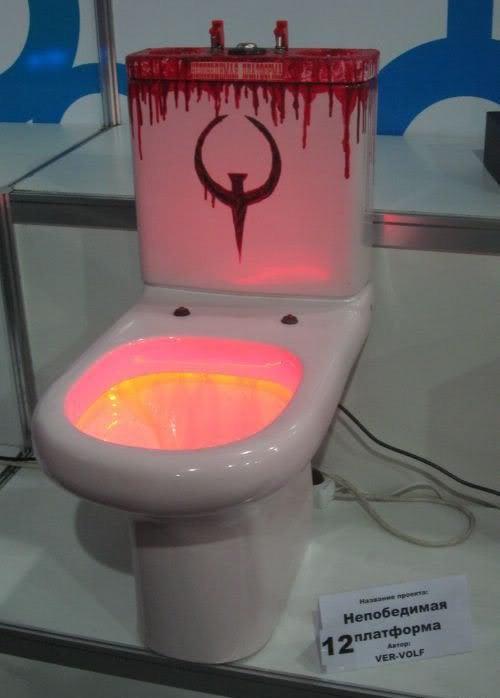
Что такое QUAKE?
Для тех, кто в танке, вернемся на 24 года назад. На дворе 1996 год. Подавляющее большинство игроков привыкло, что если в 3D-игре попытаться обойти труп противника — он всегда будет “смотреть” в камеру, этажей над этажами не существует, а плавать можно только в речке-вонючке перед домом. И тут появляется великий и могучий QUAKE и предлагает игрокам поплавать в лаве!
Помимо по-настоящему трехмерных противников и окружения, Quake предлагал освещение “лайтмапами” (технология активно используется по сей день), россыпь ловушек, платформ и разнообразных противников. Противники здесь — это не болванчики, отличающиеся друг-от-друга только количеством здоровья. Это принципиально разные враги. Одни стреляют самонаводящимися снарядами, другие — отскакивающими гранатами, третьи вообще бьют в ближнем бою и т.д. И всё это на первом Pentium!
Заслуги Джона Кармака и Ко можно перечислять долго, однако самая важная для нас сегодня заслуга — это открытые по лицензии GNU GPL исходные коды игры и игровые ресурсы для создателей карт. Так, игра получила своё бессмертие — лицензия обязывала разработчика выкладывать исходные коды, если он использовал их. И как грибы после дождя стали появляться source-порты. Один краше другого.
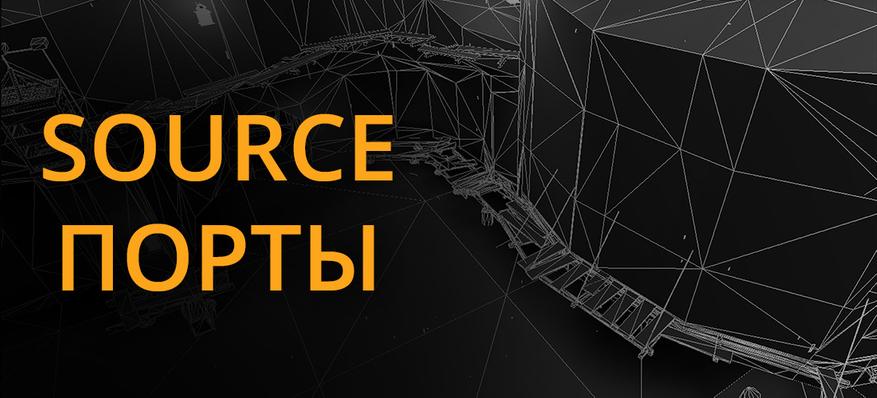
Что такое source-порт. По факту, это игра, собранная из оригинальных исходных кодов, возможно, с некоторыми улучшениями для какой-то конкретной платформы. Даже на Windows XP было проблематично играть в оригинальный Quake 1996-го года, и энтузиасты “портировали” игру на современные платформы. Сорс-порт — это не что-то одно. Их огромное количество, и все они чем-то отличаются. Обычно всё, что необходимо сделать — это поместить .exe-файл в папку с игрой и запустить.
Рассмотрим 3 моих любимых:
QBISM8 — самый “трушный” quake-опыт, с ограниченной цветовой палитрой, но это всё ещё современный движок, поддерживающий новые карты, туман, но не поддерживающий цветное освещение по понятным причинам. Графика в нём считается центральным процессором — да-да, прямо как в 90-ые, когда у людей ещё не было 3Д ускорителей. Максимально близок к DOS-версии игры без 3Д ускорения. Есть простенькие особенности, вроде рыбьего глаза.
QUAKESPASM — минимальное количество настроек, максимально простой и совместимый со всем, что только существует. Отличный выбор, если хочешь просто наслаждаться игровым процессом.
MARK V engine — опять же пример весьма хорошего движка, но с огромной россыпью настроек. У этого движка мощная консоль (не одними NOCLIP и GOD) и он подходит, пожалуй, больше для разработчиков. Если интересно покопаться с динамическим освещением и прочими современными фичами — правильный выбор. А ещё он есть на android :)
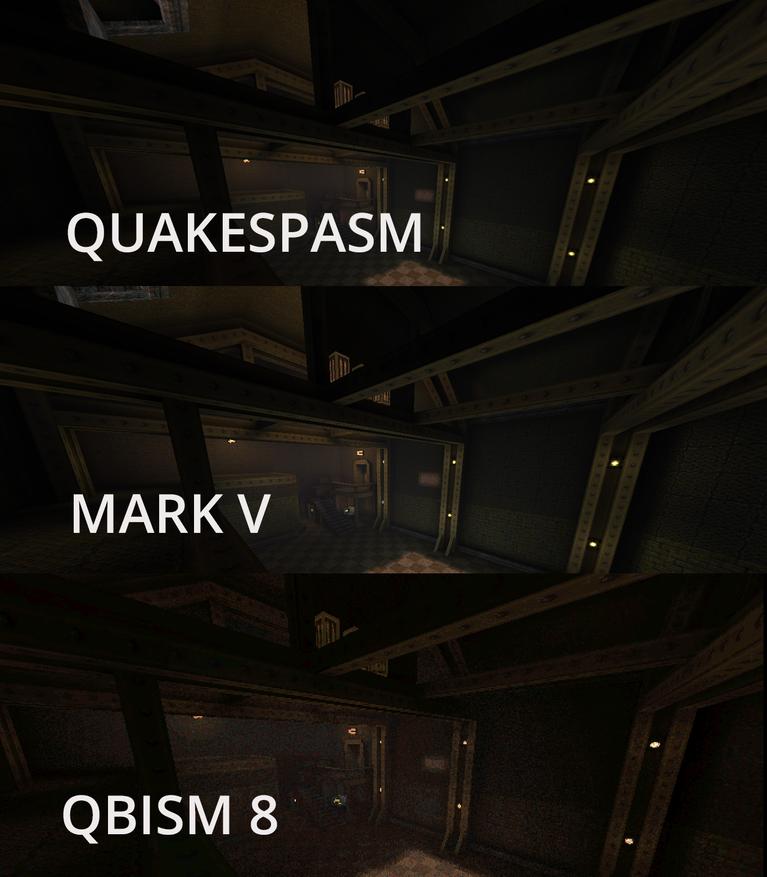
С вашего позволения “не ванильный экспирианс” мы рассматривать не будем — на мой вкус все эти блики, размытия и прочий новодел в квейке выглядит как цыганщина. Квака — она как World of Warcraft, больше про вручную нарисованные текстуры, или даже про пиксель арт. Впрочем, если хотите эффектов, их есть у меня — вышеупомянутый MARK V или же darkplaces позволяют превратить игру в буйство бликов а-ля Unreal Engine 3.
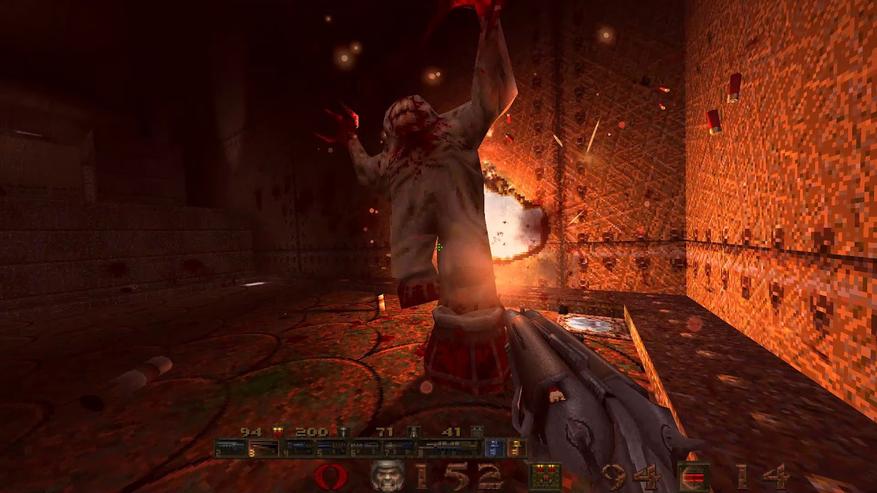
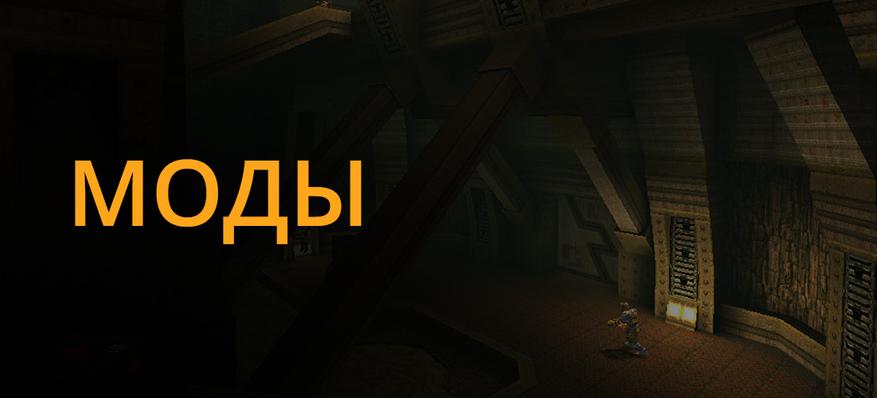
QUAKE 1.5 — пожалуй, самый «попсовый» на данный момент мод. Если пришёлся по вкусу Brutal Doom — твой выбор для прохождения оригинальной компании. Своей мод, пока что, не обзавёлся. В наличии расчленёнка да кровища, новые модели оружия, новая физика стрельбы, замедленние времени и ещё много всякого. В комплекте с модом уже идет source-порт darkplaces, и лучше использовать именно комплектный.
ARCANE DIMENSIONS (AD) — легендарный в кругах квакеров мод, вносящий новую физику всего и вся, противников, препятствия, механики и пару десятков новых карт, которым будет чем удивить. Всё это не диссонирует с оригинальной игрой ни по стилю, ни по геймплею. Своего рода “мастхев”. Также на этот мод есть и сторонние карты. Лучше всего дружит с quakespasm.
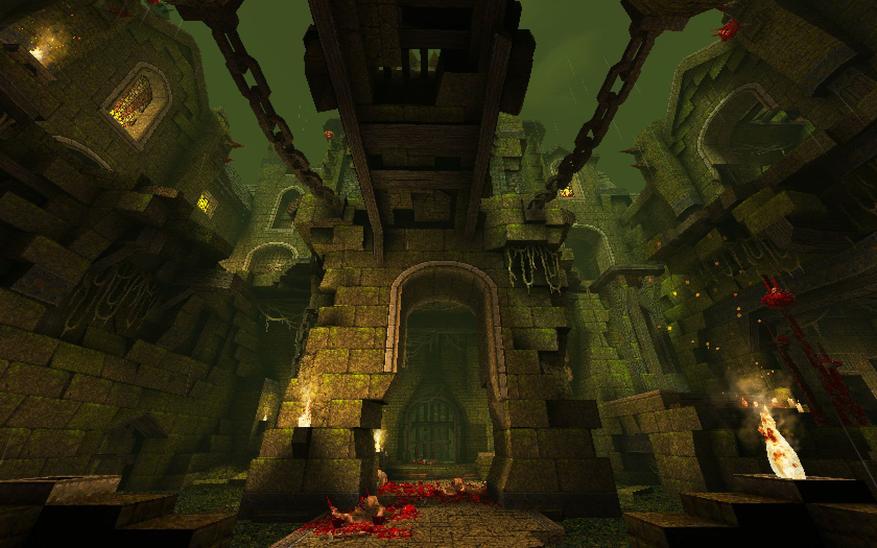
RUBICON RUMBLE PACK (RRP) — добротный маппак в стиле хай-тек. Не единственный в своем роде. Видишь карту с словом “rubicon” в названии — смело качай. Маппаки хорошо себя чувствуют на всех популярных портах.
DIMENSION OF THE PAST (DOPA) — якобы 5-ый эпизод, созданный не кем-попало, а студией machine games, которые, на секундочку, разработчики Wolfenstein: the New Order, Old Blood и New Colossus. Запускается даже на оригинальной DOS-игре.
Отдельного упоминания стоят джемы. Это нечто вроде хакатонов, если угодно, где люди в ограниченное время создают пак карт. На данный момент мап-джемов прошло очень немало, достаточно зайти на quaddicted и отсортировать карты по размеру — джем на хеллоуин, джем на рождество, тысячи их. Из последних мне понравился January Jump Jam, одна из карт в стиле метроидвании, а сам маппак включал мод на предмет, дающий дабл-джамп.
Установка всего этого добра — дело не сложное, как может показаться сперва. Обычно с модами и паками идет readme, но читать его не обязательно. Есть 2 основных случая:
1) Когда внутри скачанного архива лежит только файл/несколько формата .BSP и .LIT — это карта. Содержимое стоит запихнуть в папку ID1/MAPS/, запустить игру, нажать на тильду и написать map %название_карты%
2) Когда внутри архива много папок, допустим, maps, progs или один файл расширения .PAK — необходимо создать новый каталог в папке с игрой, создать ярлык на .exe-файл вашего source-порта и в пути прописать -game %название_новой_папки%. Вот пример:
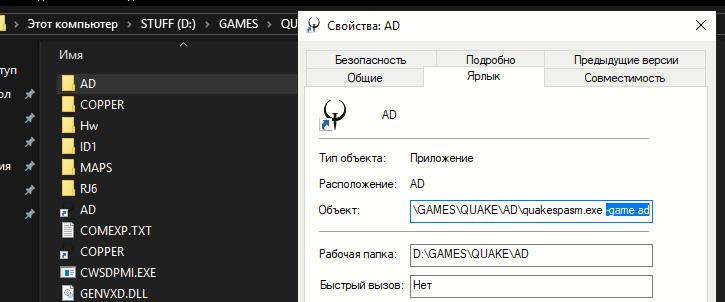
Я хочу поиграть в arcane dimensions, я создаю папку AD, отправляю в неё содержимое архива, создаю ярлык на свой quakespasm и дописываю -game ad. После старта игра начнется уже в стартовой локации мода.
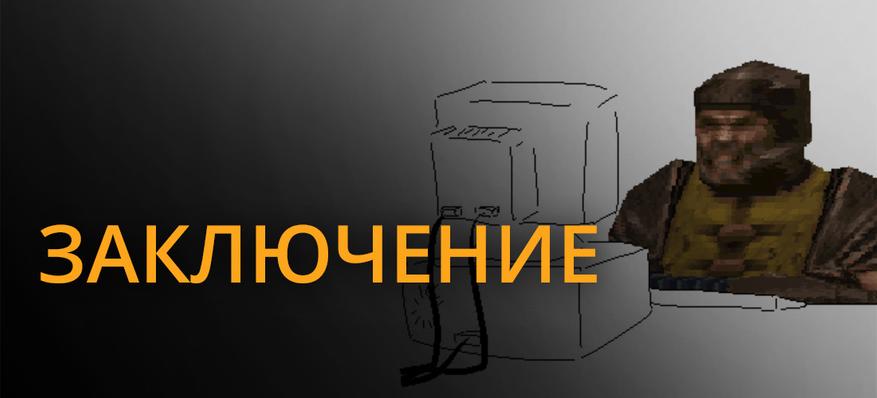
Quake жил, жив и будет жить. Количество инструментов для разработки, карт, модов растет с бешеной прогрессией, а разработкой этих инструментов зачастую занимаются профессионалы, по юности полюбившие quake. Если же конкретно ты хочешь стать в будущем левел/гейм-дизайнером — для тебя это также может послужить отличной практикой, благо инструменты удобные, простые и современные, да и видео с мануалами полно (например, канал dumptrack_ds). Если же ты просто любишь драйвовые аркадные шутеры — лучше ознакомься с этой игрой и творчеством фанатов. Сейчас quake — куда больше, чем просто игра. Это платформа, на которую вышло и выйдет невероятное количество контента, часто от профессионалов своего дела. Это как “новомодные” игры с пользовательскими картами, вроде super mario maker, только бесплатно (за исключением файлов оригинальной игры, но это если совсем легально). Достаточно просто сделать пару кликов мышью — и вот оно, счастье.
Надеюсь, тебе было интересно. Спасибо что дочитал, и поменьше шемблеров на твоём пути.
Читайте также:


